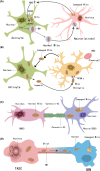Intercellular mitochondrial transfer in the brain, a new perspective for targeted treatment of central nervous system diseases
- PMID: 37424172
- PMCID: PMC10580346
- DOI: 10.1111/cns.14344
Intercellular mitochondrial transfer in the brain, a new perspective for targeted treatment of central nervous system diseases
Abstract
Aim: Mitochondria is one of the important organelles involved in cell energy metabolism and regulation and also play a key regulatory role in abnormal cell processes such as cell stress, cell damage, and cell canceration. Recent studies have shown that mitochondria can be transferred between cells in different ways and participate in the occurrence and development of many central nervous system diseases. We aim to review the mechanism of mitochondrial transfer in the progress of central nervous system diseases and the possibility of targeted therapy.
Methods: The PubMed databank, the China National Knowledge Infrastructure databank, and Wanfang Data were searched to identify the experiments of intracellular mitochondrial transferrin central nervous system. The focus is on the donors, receptors, transfer pathways, and targeted drugs of mitochondrial transfer.
Results: In the central nervous system, neurons, glial cells, immune cells, and tumor cells can transfer mitochondria to each other. Meanwhile, there are many types of mitochondrial transfer, including tunneling nanotubes, extracellular vesicles, receptor cell endocytosis, gap junction channels, and intercellular contact. A variety of stress signals, such as the release of damaged mitochondria, mitochondrial DNA, or other mitochondrial products and the elevation of reactive oxygen species, can trigger the transfer of mitochondria from donor cells to recipient cells. Concurrently, a variety of molecular pathways and related inhibitors can affect mitochondrial intercellular transfer.
Conclusion: This study reviews the phenomenon of intercellular mitochondrial transfer in the central nervous system and summarizes the corresponding transfer pathways. Finally, we propose targeted pathways and treatment methods that may be used to regulate mitochondrial transfer for the treatment of related diseases.
Keywords: central nervous system; mitochondrial transfer; targeted therapy.
© 2023 The Authors. CNS Neuroscience & Therapeutics Published by John Wiley & Sons Ltd.
Conflict of interest statement
The authors have no personal, financial, or institutional interest in any of the drugs, materials, or devices described in this article.
Figures
Similar articles
-
Intercellular Mitochondrial Transfer: The Novel Therapeutic Mechanism for Diseases.Traffic. 2024 Sep;25(9):e12951. doi: 10.1111/tra.12951. Traffic. 2024. PMID: 39238078 Review.
-
Prospective Approach to Deciphering the Impact of Intercellular Mitochondrial Transfer from Human Neural Stem Cells and Brain Tumor-Initiating Cells to Neighboring Astrocytes.Cells. 2024 Jan 23;13(3):204. doi: 10.3390/cells13030204. Cells. 2024. PMID: 38334595 Free PMC article.
-
Inter and Intracellular mitochondrial trafficking in health and disease.Ageing Res Rev. 2020 Sep;62:101128. doi: 10.1016/j.arr.2020.101128. Epub 2020 Jul 23. Ageing Res Rev. 2020. PMID: 32712108 Free PMC article. Review.
-
Mitochondria Know No Boundaries: Mechanisms and Functions of Intercellular Mitochondrial Transfer.Front Cell Dev Biol. 2016 Sep 28;4:107. doi: 10.3389/fcell.2016.00107. eCollection 2016. Front Cell Dev Biol. 2016. PMID: 27734015 Free PMC article. Review.
-
Mitochondrial transfer/transplantation: an emerging therapeutic approach for multiple diseases.Cell Biosci. 2022 May 19;12(1):66. doi: 10.1186/s13578-022-00805-7. Cell Biosci. 2022. PMID: 35590379 Free PMC article. Review.
Cited by
-
Mitochondrial mechanisms in the pathogenesis of chronic inflammatory musculoskeletal disorders.Cell Biosci. 2024 Jun 8;14(1):76. doi: 10.1186/s13578-024-01259-9. Cell Biosci. 2024. PMID: 38849951 Free PMC article. Review.
-
Cytokines and Madness: A Unifying Hypothesis of Schizophrenia Involving Interleukin-22.Int J Mol Sci. 2024 Nov 11;25(22):12110. doi: 10.3390/ijms252212110. Int J Mol Sci. 2024. PMID: 39596179 Free PMC article. Review.
-
Harnessing Mitochondrial Transplantation to Target Vascular Inflammation in Cardiovascular Health.JACC Basic Transl Sci. 2025 Aug;10(8):101331. doi: 10.1016/j.jacbts.2025.101331. Epub 2025 Jul 25. JACC Basic Transl Sci. 2025. PMID: 40714674 Free PMC article. Review.
-
Insights into therapeutic approaches for the treatment of neurodegenerative diseases targeting metabolic syndrome.Mol Biol Rep. 2025 Feb 21;52(1):260. doi: 10.1007/s11033-025-10346-0. Mol Biol Rep. 2025. PMID: 39982557 Review.
-
Molecular and cellular mechanisms of mitochondria transfer in models of central nervous system disease.J Cereb Blood Flow Metab. 2024 Nov 14:271678X241300223. doi: 10.1177/0271678X241300223. Online ahead of print. J Cereb Blood Flow Metab. 2024. PMID: 39539186 Free PMC article. Review.
References
-
- Gustafsson C, Falkenberg M, Larsson N. Maintenance and expression of mammalian mitochondrial DNA. Annu Rev Biochem. 2016;85:133‐160. - PubMed
Publication types
MeSH terms
Substances
LinkOut - more resources
Full Text Sources
Miscellaneous


